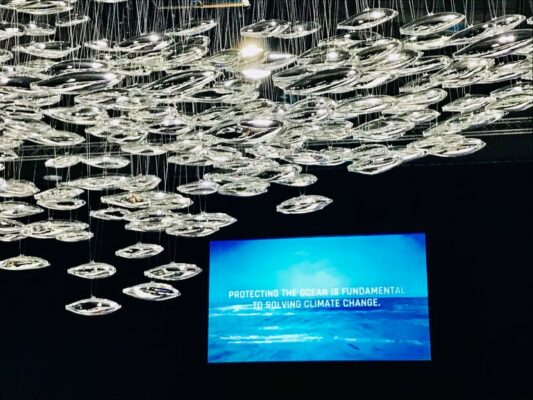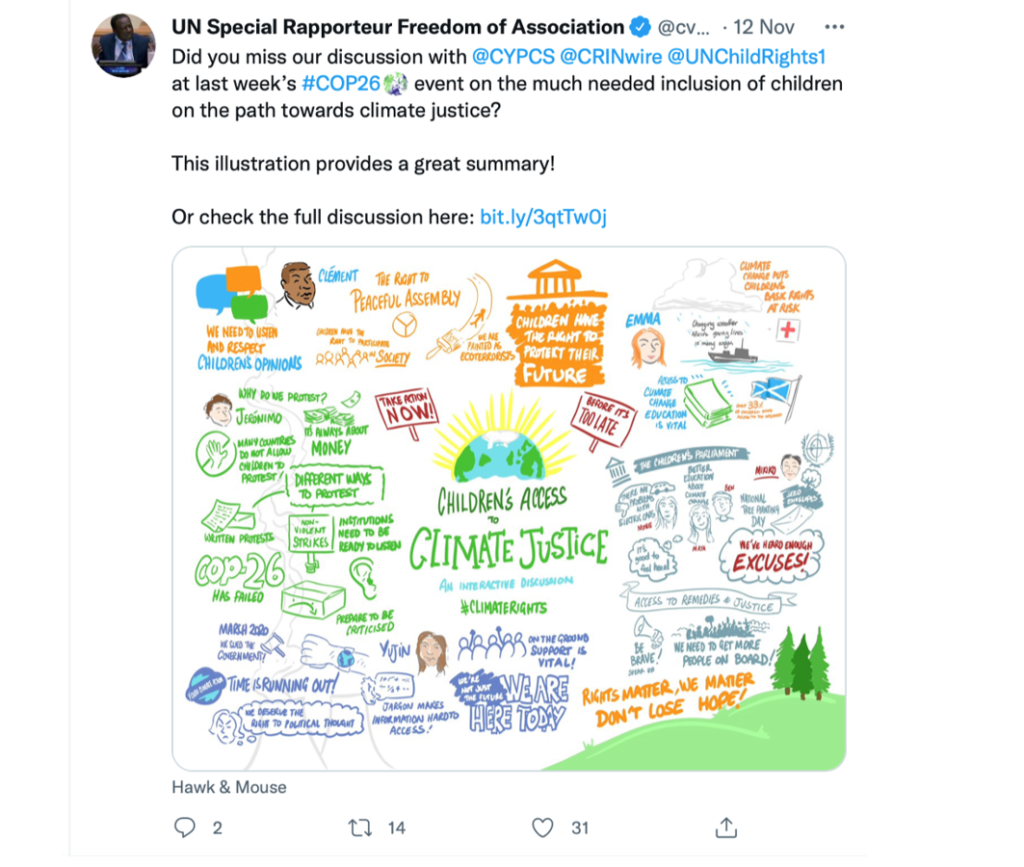COP26: what news for the ocean?

Art installation presented at COP26. Photo: Elisa Morgera

After COP25 in Madrid in 2019 was labelled the ‘Blue COP’, expectations were high for COP26 to embed the ocean into future climate-related action at all levels. Against the benchmark of the expectations the One Ocean Hub had set out before COP26, this blog post will provide a rapid assessment of the significance for the ocean of the outcomes of the UN Climate Conference (COP26) held in Glasgow, Scotland, from 31 October-13 November 2021. The assessment will address on the following questions:
- To what extent has the ocean been integrated in the international climate change regime?
- Are COP26 outcomes on climate change mitigation good enough for the ocean?
- Were there ocean-related developments in terms of adaptation, finance, technology transfer and carbon markets?
- Were human rights standards taken into account in COP26 outcomes related to participation?
To what extent has the ocean been integrated in the international climate change regime?
Despite the challenges of the pandemic, the momentum for better integrating the ocean in the international regime established under the UN Framework Convention on Climate Change (UNFCCC) and its Paris Agreement was maintained after COP25 through informal consultation on oceans and climate. The “Glasgow Climate Pact” (the overarching decisions adopted at COP 26: 1/CP.26, 1/CMP.16 and 1/CMA.3 – all in advance unedited version at the time of writing) makes direct reference to the need to ensure the integrity of ocean ecosystems (preamble, para. 5) and the:
“importance of protecting, conserving and restoring natures and ecosystems, including …marine ecosystems, to achieve the long-term global goal of the Convention by acting as sinks and reservoirs of greenhouse gases and protecting biodiversity, while ensuring social and environmental safeguards” (1/CP.26, para. 21).
These references to marine ecosystem protection and restoration are quite significant to build bridges between action on the ocean, biodiversity and climate change, and has potential to support the protection of human rights and Sustainable Development Goals synergies (as the Hub explored in a COP26 side-event).
The Glasgow Climate Pact also invites:
“the relevant work programmes and constituted bodies under the UNFCCC to consider how to integrate and strengthen ocean-based action in their existing mandates and workplans and to report on these activities within the existing reporting processes, as appropriate” (1/CP.26, para. 60)
and
“the Chair of the Subsidiary Body for Scientific and Technological Advice [SBSTA] to hold an annual dialogue, starting at the fifty-sixth session of the Subsidiary Body for Scientific and Technological Advice (June 2022), to strengthen ocean-based action and to prepare an informal summary report thereon and make it available to the Conference of the Parties at its subsequent session” (1/CP.26, para. 61).
The Glasgow Climate Pact does therefore integrate officially the ocean for the first time across all areas of work under the Convention, also thanks to the efforts of the Because The Ocean initiative. That said, the Glasgow Climate Pact does so in a quite generic way: it does not define the term ‘ocean-based action’ or provide for more specific guidance on key issues or priorities as yet. The recurring annual oceans-climate dialogue – which was called for by several States in June this year – will be helpful to keep high-level interest going on the climate-ocean nexus, but it is really the technical work of the UNFCCC bodies in conjunction with cooperation of Parties that can allow for support and monitoring of ocean-based action for mitigation and adaptation purposes. At least the request for the various bodies and work programmes under the UNFCCC to report back at COP27 next year gives some timeframe and form of accountability, and could pave the way for an oceans-focused decision next year.
In addition, SBSTA identified key research action items, that are also crucial to advance the consideration of the ocean into the international climate change regime. SBSTA:
- encourages UNFCCC parties to understand the opportunities for and challenges of implementing nature-based solutions in land and ocean ecosystems for supporting adaptation and mitigation action; and
- calls for further understanding of knowledge gaps, including tipping points and incremental transformations in climate system, including in the ocean.
Finally, the decision on the new work plan for the Local Communities and Indigenous Peoples Platform, which contributes to the respectful integration of indigenous and local knowledge into international climate change policy, recommendsthat the activities under the second three-year workplan facilitate exchange of experience between indigenous peoples and local communities and Parties of approaches to managing all ecosystems, which are key to achieving the objectives of the Convention and the Paris Agreement, in order to enhance national climate policy, including nationally determined contributions. This potentially bodes well for future integration of indigenous and local knowledge at the ocean-climate nexus.
Are COP26 outcomes on climate change mitigation good enough for the ocean?
As the ocean is already negatively impacted in so many ways by climate change, general progress at COP26 on climate change mitigation is crucial for the ocean. The Glasgow Climate Pact made an explicit reference to:
“limiting global warming to 1.5°C, which requires rapid, deep and sustained reductions in greenhouse gas emissions, including global carbon dioxide by 45% by 2030 and net-zero by 2050.”
The explicit reference to carbon dioxide is very important to curb also ocean acidification, which arises from excess CO2 emissions dissolving in sea water.
More generally, there are different estimates as to whether the new National Determined Contributions (NDCs) and net zero pledges, taken together with NDCs and net zero pledges submitted before COP26, would lead to 1.8°C to 2.4°C of global warming by 2100, if these pledges are fully implemented. As Earth Negotiations Bulletin commentators noted, it remains to be clarified how pledges will prove credibility and accountability, if they are not reflected in future NDCs. Our previous assessment of the NDCs highlighted that more work needs to be done to mainstream marine issues into all aspects of the climate change policy discussion. For example, only 1/3 of NDCs submitted to the UNFCCC Secretariat contained a reference to the ocean or fisheries. A full NDC Synthesis report was published in September this year, which indicated Parties considered ocean acidification and loss of marine biodiversity as key adaptation priorities (para. 158), as well as research efforts focused on the ocean and coastal areas (para. 159). However, the full synthesis report confirmed that less than 1/3 of the adaptation components of the NDCs contained a reference to ocean ecosystems as an adaptation priority.
In Glasgow, countries also agreed on:
- submitting stronger 2030 emissions reduction targets with the aim of closing the gap to limiting global warming to 1.5°C;
- submitting long-term strategies to 2050, aiming for a just transition to net-zero emissions around mid-century;
- using common timeframes for their national climate commitments, which should allow for more comparability;
- submitting standardized information about their emissions and financial, technological and capacity-building support.
As NDCs and net-zero targets are not yet adding up to what is needed to limit global warming to 1.5°C, it is imperative that countries revisit their 2030 targets and achieve much deeper emission reductions in the 2020s. Serious progress in emissions reductions is needed to prevent further negative impacts on the ocean in terms of:
- Ocean acidification;
- Loss of coral-reef ecosystems;
- Fish stocks shifting out of the tropics and toward the poles;
- Ocean deoxygenation; and
- the arising risks for the economic and food security, as well as the health and culture, of local communities dependent on the ocean and the ecosystem services it provides.
Specific commitments on fossil fuels are also relevant for the ocean, as the production of fossil fuel is linked to the production of plastic, much of which ends up contributing to ocean plastic pollution, as recently highlighted by the UN Special Rapporteur on Toxics. While COP26 did not make a commitment on phasing out oil and gas production, the Glasgow Climate Pact does include a reference to “phasing-out of inefficient fossil fuel subsidies,” which may contribute to discouraging further oil and gas (and plastic) production. In addition, the Beyond Oil and Gas Alliance, led by Costa Rica and Denmark pledged to end new licensing rounds for oil and gas exploration and production and set an end date that is aligned with Paris Agreement objectives.
Were there ocean-related developments in terms of adaptation, finance and technology transfer?
On adaptation, Parties to the Paris Agreement adopted the Glasgow-Sharm el-Sheikh work programme for the Global Goal on Adaptation to help improve over 2022-2024 the assessment of progress in adaptation through regular workshops and work on methodologies. This decision, in conjunction with the request of UNFCCC bodies and work programmes to explore how to better integrate ocean-based action in their work could prove promising in integrating the ocean in climate adaptation rules, financing and technology transfer at subsequent COPs. Relevant bodies under the UNFCCC in this context include the Nairobi Work Programme, the Adaptation Fund, and the Adaptation Committee.
On finance, at COP26 countries committed to: doubling adaptation finance; keeping the USD 100 billion goal on the agenda until 2027 (which was meant to be reached in 2020); and establishing awork programme to deliberate on the new finance goal (as summarized by the Earth Negotiations Bulletin). But without explicit references to the ocean, it remains unclear if efforts will remain focused on land. In theory, the climate-ocean nexus can be addressed on the basis of the more generic reference to ensuring co-benefits for climate finance, but the COP26 decision on “matters related to the Committee on Finance” (para 69) notes that
“Overall, the needs identified by developing countries touch on all SDGs, with 75 per cent of NDCs having linkages to SDGs 2, 6, 7, 8, 9, 11, 12, 13, 15 and 17.”
It is thus notable that SDG 14 is not listed there, and it can be hoped that the request to UNFCCC bodies and work programmes to include ocean-based action in their work will help, over time, centre the ocean in climate finance.
On technology transfer, it is noteworthy that the Technology Executive Committee has been invited to continue using events such as the Technology Day in 2020 and 2021 to promote innovative approaches on adaptation technologies related to ocean and coastal adaptation (para. 10). Once again, increased attention to ocean-based action across UNFCCC bodies and work programmes may bring along also broader understanding of related technology transfer under the international climate change regime.
On carbon markets, COP26 adopted new decisions completing the Paris rulebook, which are widely seen as a major achievement (see Earth Negotiations Bulletin). The lack of references to human rights and to an independent grievance mechanism in this context, however, has been criticized by UN Special Rapporteur on Human Rights and other observers. David Boyd the current UN Special Rapporteur on Human Rights, in a series of tweets, highlighted:
“Strong human rights safeguards, including an independent grievance mechanism, in the rules governing the Article 6 carbon market mechanism, consistent with [Global Environment Facility], [Green Climate Fund] etc established practices and ensuring no repeat of fraud and human rights under Kyoto mechanisms”
With increasing research on blue carbon, it is important to take stock of the lessons learnt in land-based carbon markets to avoid repeating, in the context of the marine environment, exclusionary practices that have led to well-documented human rights violations on land.
Participation and human rights
Concerns about participation were very high already before COP26 started. These concerns were confirmed as COP26 unfolded and the vast majority of observers could not have access to the negotiating rooms. In addition, many international observers and civil society expressed great disappointment that new 10-year Glasgow work programme on Action for Climate Empowerment did not include references to human rights standards of public participation. Parties and non-party stakeholders are merely:
“encouraged to promote public participation in addressing climate change and its effects and in developing adequate responses by facilitating feedback, debate and partnership in relation to climate change activities and relevant governance, noting the important role that social media platforms and strategies can play in this context.” (para. 22).
The Glasgow Climate Pact sought to compensate this limitation, by:
- recognizingthe important role of indigenous peoples, local communities, youth and children, in addressing and responding to climate change;
- calling for promoting and considering respective obligations on human rights in implementing the Glasgow work programme on Action for Climate Empowerment; and
- calling for annual youth-led climate forum with a view to contributing to the implementation of the Glasgow work programme on Action for Climate Empowerment (paras 55, 62 and 64-65).
The last proposal, however, does not respond to the specific calls made repeatedly by youth representativesat COP 26tobe included in the negotiations, not only in separate, youth-focused events. The UN Special Rapporteur on Freedom of Association followed closely the practices at COP26, lamenting how limitations to civil society and representatives of human rights-holders in accessing the negotiations were a major barrier to realizing climate justice and to the protection of children’s rights in particular. This is indeed a crucial aspect for children’s human rights to healthy environment, which hinges also upon the ocean-climate nexus.
